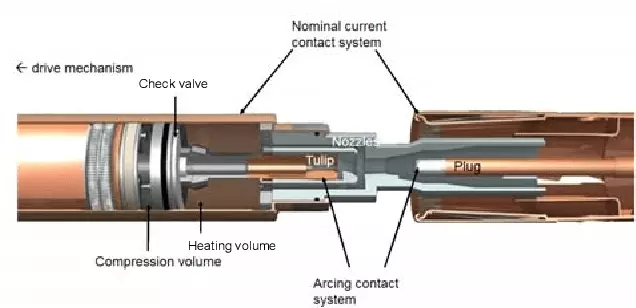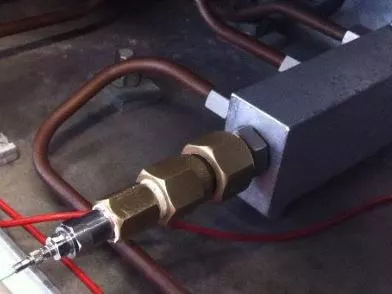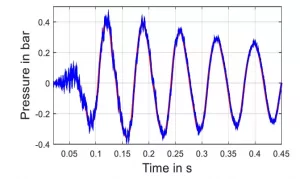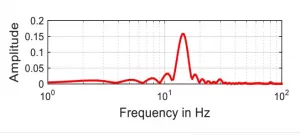
Photo from source No 4 ( just for show)
About high voltage SF6 circuit breaker nozzle:
SF6 gas circuit breaker manufacturers require disassembly and visual inspection of the interrupter main contacts, arcing contacts, and gas nozzles to determine their condition and if replacement is necessary.
Historically these inspections have been based on time, electrical operations, fault operations, or a combination. For example, after ten operations at rated short-circuit breaker operations, 2000 electrical operations, or twelve years for single pressure SF6 dead tank circuit breakers, a contact inspection is recommended.
As these single pressure, SF6 gas circuit breakers have become the industry standard, over the past thirty years, these maintenance intervals have been reached. However, the resulting inspections did not prove to be good indicators of contact and nozzle wear. The inspections were costly, inconsistent, and had the potential for damage due to the inherent risks involved in an internal inspection performed in the field.
An electrical arc is a very complicated and extraordinarily complex thermal and electrical process. Electric arc affects the circuit breaker parameters in many ways and one of the ways is through nozzle ablation. Nozzle ablation has a dual influence on circuit breaker breaking capability: an increase in the pressure inside the circuit breaker chambers and an increase n the nozzle throat cross-section. Therefore, the nozzle ablation process has both positive and negative effects on the braking capability of a self-blast circuit breaker. When the
circuit breaker breaks short circuit currents, the nozzle ablation process takes away a part of the energy from the arc column, increases the mass of the gas in the nozzle space and this leads to an increase in the density of the gas around the arcing contacts, thus providing a lower probability of re-ignition.
Because of this, estimating the nozzle ablation intensity, which means the increase in the nozzle throat diameter and calculating the ablation mass, becomes a very important task.
You can see some of the problems in the right picture photo 1 for the high voltage circuit breakers:

Photo1: Nozzle problem in high voltage gas circuit breakers(photo from Cigre brochure 725)
Nozzle Ablation measurement method in high voltage circuit breaker:
The presented research work focuses on the estimation of the nozzle ablation by evaluating the pressure signal at the gas connection valve of the circuit breaker during a non-load switching operation. Simulative investigations indicate a change of the pressure signal after changing the nozzle diameter. The simulative results are validated by measurements. In addition, a classification method can be derived from the marker of the pressure signal.
Up to now nozzle ablation, due to the thermal effects of the arc while switching, could not have been determined without opening the gas chamber. Now, a minimum-invasive and offline diagnostic technique has been developed to assess the wear of the insulation nozzle inside the switching chamber of a CB. The pressure signal is investigated regarding characteristic features which yield information for the determination of the switching chamber condition. A machine learning algorithm applying the k-Nearest-Neighbor-method is used for the determination of the nozzle and electrode condition, while the characteristic features are utilized as input parameters. Thus, it is possible to classify new unknown measurements with an already known data basis. The method can be used in high voltage CBs.
Different connection points are possible for the connection of the pressure sensor. A single valve is located at the bottom of each pole. By using this connection for the pressure sensor, the pressure wave of only one pole is considered. During standard operation, the three poles are connected by copper pipes. The main filling valve is located inside the chassis of the circuit breaker and links all three poles.
While using the main filling valve as the connection port for the pressure sensor, the measured signal is the superposition of the three single pressure signals.
For the pressure measurements, a high sensitive piezoelectric pressure sensor with a suitable charge
the amplifier is used(show in this photo 2):

Photo 2: Connection point with pressure sensor for nozzle ablation(photo from the source no 1)
The raw data of the pressure measurement is cut from the start of the switching operation until the
end of the 6th oscillation. This signal can be processed with and without filtering. A fast Fourier transformation is applied to the unfiltered signal. Additionally, the signal is filtered with a 100 Hz lowpass filter.
Figure 1 and Figure 2 show the pressure history and frequency spectrum.

Figure 1:Raw data of measurement at the main filling valve in original condition (blue), filtered signal (red)(photo from the source no 1)

Figure 2: Frequency spectrum of raw data in high voltage circuit breaker pressure method(photo from the source no 1)
Several markers can be derived from the filtered and unfiltered pressure signal. These markers capture characteristics of the different measurement signals and can be used to identify the nozzle conditions.
Due to the wide scattering of the markers a simple matching of the different ablation cases with the markers is not possible. For this reason, the k-Nearest-Neighbor Algorithm is used for the evaluation.
The Algorithm generates a base n vector for each measurement, where n is the number of markers.
The distance calculation between two vectors is based on the Euclidean distance with an additional weighting with the variance.
Conclusion about transient pressure method in high voltage circuit breaker nozzle ablation:
The method is easy to apply because an already existing filling valve can be used to connect a pressure
sensor. However, it is difficult to diagnose the nozzle condition because the condition indicators
(markers) values are widely scattered.
The marker scales are optimized with a sensitivity analysis. These can be used to classify an ablated nozzle, but one marker alone does not bear enough information for all cases. The sum of all seven markers in combination with a classification algorithm is required.
Different classification algorithms have been tested with the result that the k-Nearest-Neighbor Algorithm with
the Standard Euclidean distance holds the lowest error rate of less than 0.9% in cross-validation. The combination of markers and the k-Nearest-Neighbor Algorithm is used to classify field measurements from different circuit breaker types. This can be performed without any error for the regarded circuit breaker measurements.




Dear sir,
We are interested in your products plz repla back to me sir
I will connect you.